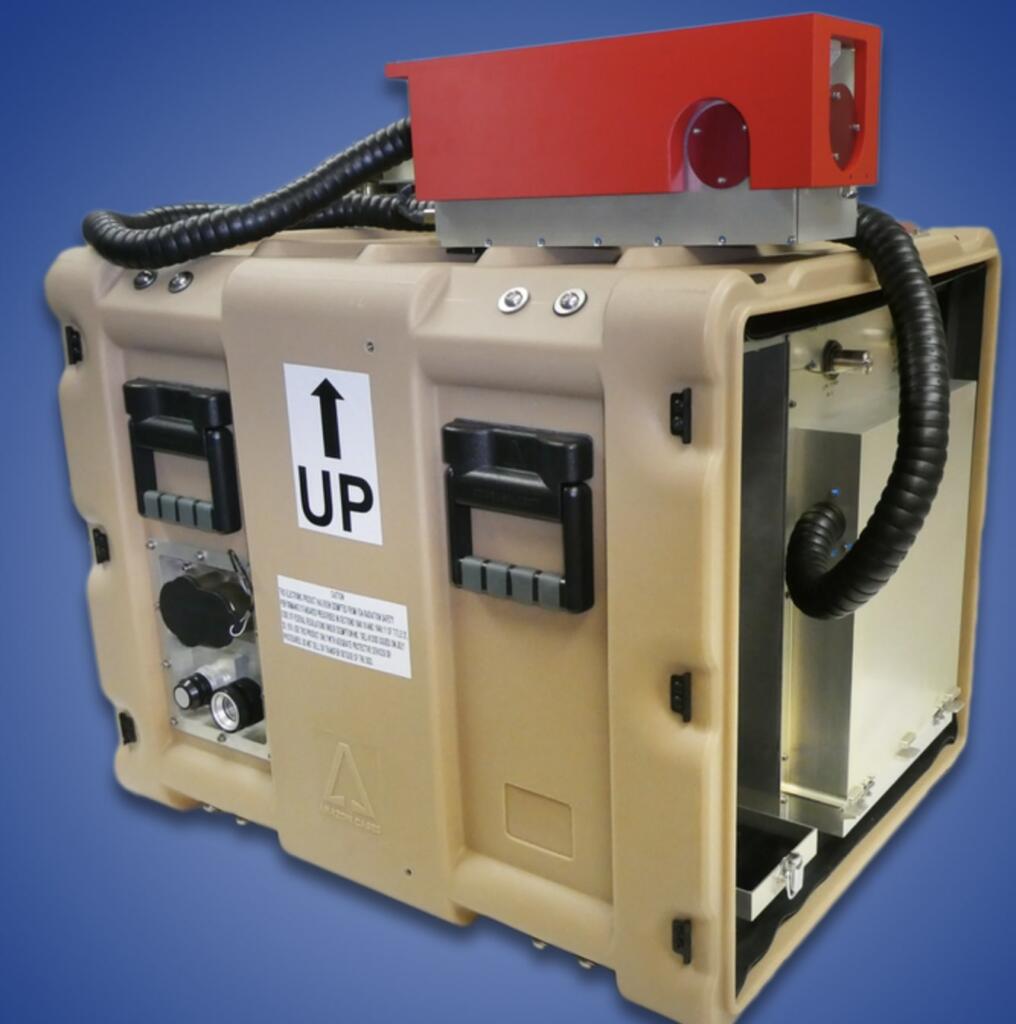In July 2023 Lockheed Martin (NYSE: LMT) announced they will scale its laser technology to a new benchmark: a 500 kW-class laser, the most powerful laser Lockheed Martin has produced, topping its 300 kW-class laser power level developed under a contract from the Department of Defense. This is the second phase of the High Energy Laser Scaling Initiative (HELSI).
Above is the compact 500 kilowatt laser concept art from Lockheed. They will further reduce size and weight and increase power to MW [megawatt] levels by FY2026.
On April 10, 2020, the Department of Defense selected General Atomics as a third prime contractor to join previously selected prime contractors Lockheed Martin, and nLight/Nutronics in building high energy lasers for the High Energy Laser Scaling Initiative (HELSI). Each developer will produce a 300 kW class high energy laser (HEL) source prototype with an architecture scalable to 500 kW or beyond, using a unique technology approach. The focus is on common, multi-Service/Agency needs for HEL (high energy laser) improvements.
HELSI funding awards –
nLight/Photonics [nLight/Nutronics], $48 million award: The performer will develop a 300 kW class HEL device based on coherent beam combined technology. —
Lockheed-Martin, $83 million award: The performer will develop a spectral beam combined fiber laser prototype. —
General Atomics, $47 million: The performer will develop a distributed gain laser prototype.
The Army has sponsored Lockheed Martin’s 300-kilowatt laser, which will be used for the Indirect Fire Protection Capability-High Energy Laser (IFPC-HEL) program, while the other HELSI vendors include Nutronics Inc. sponsored by the Navy and General Atomics by the Air Force.
The Pentagon has been spending about $1 billion per year researching directed energy weapons like lasers and microwave weapons for decades. They have bought a few demonstration systems for Navy ships and mounted on trucks.
The Missile Defense Agency (MDA) is the group tasked with being able to defend against ICBM and other enemy nuclear missiles and nuclear weapons on planes. The MDA has a budget over over $10 billion per year and have requested about $55 billion over the next five years. Around 80% of their budget is for research and development. They also buy new radar, space based sensing and anti-missile missile systems. The US military acquires new military gear and spends around $200 billion not counting the weapons that get used up in the many US wars.
“I think part of [why] the Missile Defense Agency in the past few years kind of backed away was that technology needed still needed to mature. It needed to mature in power levels that could be delivered on target, and needed to mature and reduction of the size, weight and power requirements to produce the directed-energy effects,” explained Laura DeSimone, MDA executive director.
With directed-energy research now coming to fruition, the Missile Defense Agency is putting “increased emphasis” on development of directed-energy weapons for shooting down adversary missiles.
However in recent months, the agency has seen “that technology maturation is happening,” DeSimone said, including at the US national laboratories, the Department of Energy and within industry.
“I mean, there have been some really impressive results,” DeSimone said. “We’ve been doing studies all along, and looking at lethality effects and doing experimentation. But we think that, finally, we’re starting to see some real progress and, and so that’s why the increased emphasis.”
The US military and MDA were willing to spend a $1 billion per year on lasers and directed energy weapons when they were not mature and did not have a real chance of being useful defensive systems. How much will spending go up now that the MDA thinks usable megawatt anti-ICBM lasers are getting within reach?






Brian Wang is a Futurist Thought Leader and a popular Science blogger with 1 million readers per month. His blog Nextbigfuture.com is ranked #1 Science News Blog. It covers many disruptive technology and trends including Space, Robotics, Artificial Intelligence, Medicine, Anti-aging Biotechnology, and Nanotechnology.
Known for identifying cutting edge technologies, he is currently a Co-Founder of a startup and fundraiser for high potential early-stage companies. He is the Head of Research for Allocations for deep technology investments and an Angel Investor at Space Angels.
A frequent speaker at corporations, he has been a TEDx speaker, a Singularity University speaker and guest at numerous interviews for radio and podcasts. He is open to public speaking and advising engagements.


This seems like a big deal for the reasons that DPD mentions.
So what happens to all of our strategic assumptions and plans when lasers can swat ballistic missiles, cruise missiles and bombers out of the sky?
Does the concept of mutual assured destruction then become null and void and everyone’s nuclear deterrent ceases to exist?
Without fear of nuclear annihilation can we proceed with conventional world wars again?
Yes, you may proceed now. Eek.
I know that probably wasn’t your angle haha but rather assume you were raising the spectre of an undesirable upsurge in conventional conflicts – if laser-armed robot wars can be described as such.
You also unwittingly reminded me of a video I saw yesterday where the host was complaining about everyone being too woke and reasoning it was because things had been so peaceful for the past few decades and they didn’t have enough, I quote, “important things to be doing like fighting WW3”. Certainly an interesting definition of important, which made me raise a brow…
US satellite lasers currently can swat Russian intercontinental missiles out of the sky. 300 KW is enough. US has a window of opportunity to confront Russia with impunity and is doing so in Ukraine. Occasional inexplicable fires around the world can be explained. The meek gradual approach to the war with Russia by President Jill Biden is partly because she is a woman and partly because cheapskates France and Germany stand naked never having invested in defending themselves.
Surely someone has questioned what happens when mirror finishes are used on targets.
Diode arrays scale quite nicely.